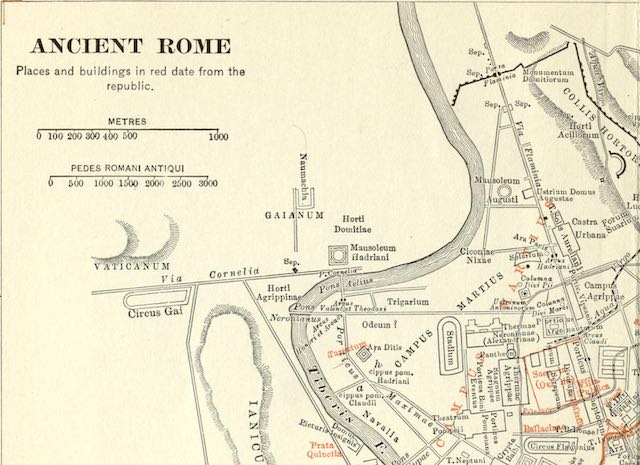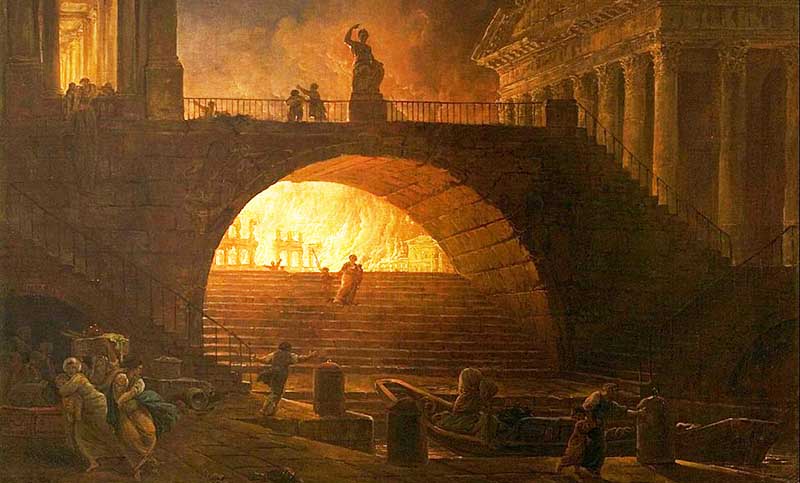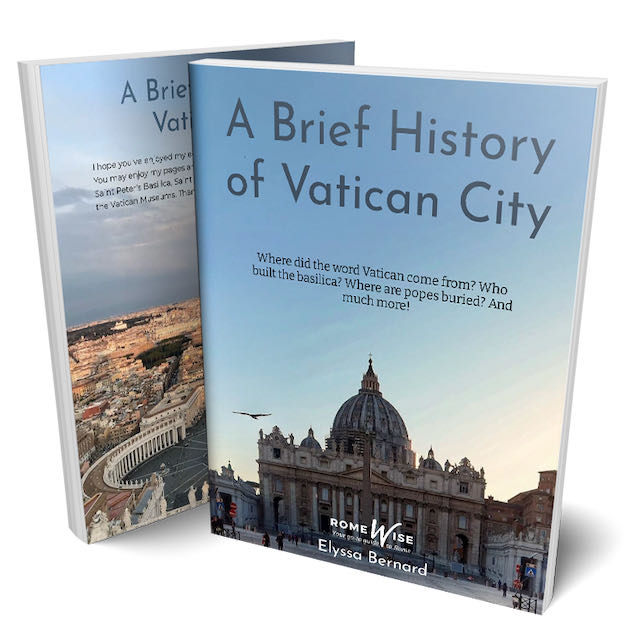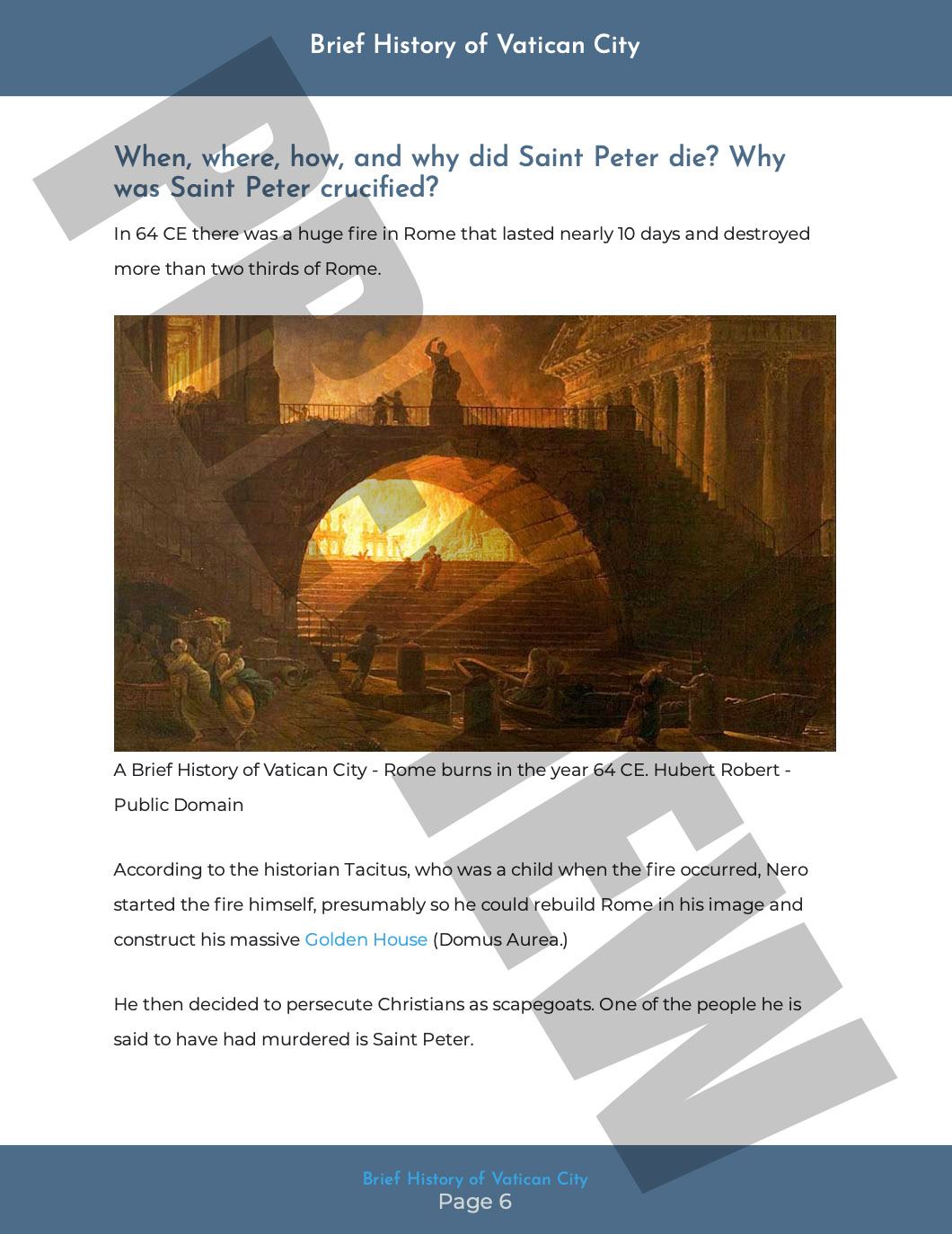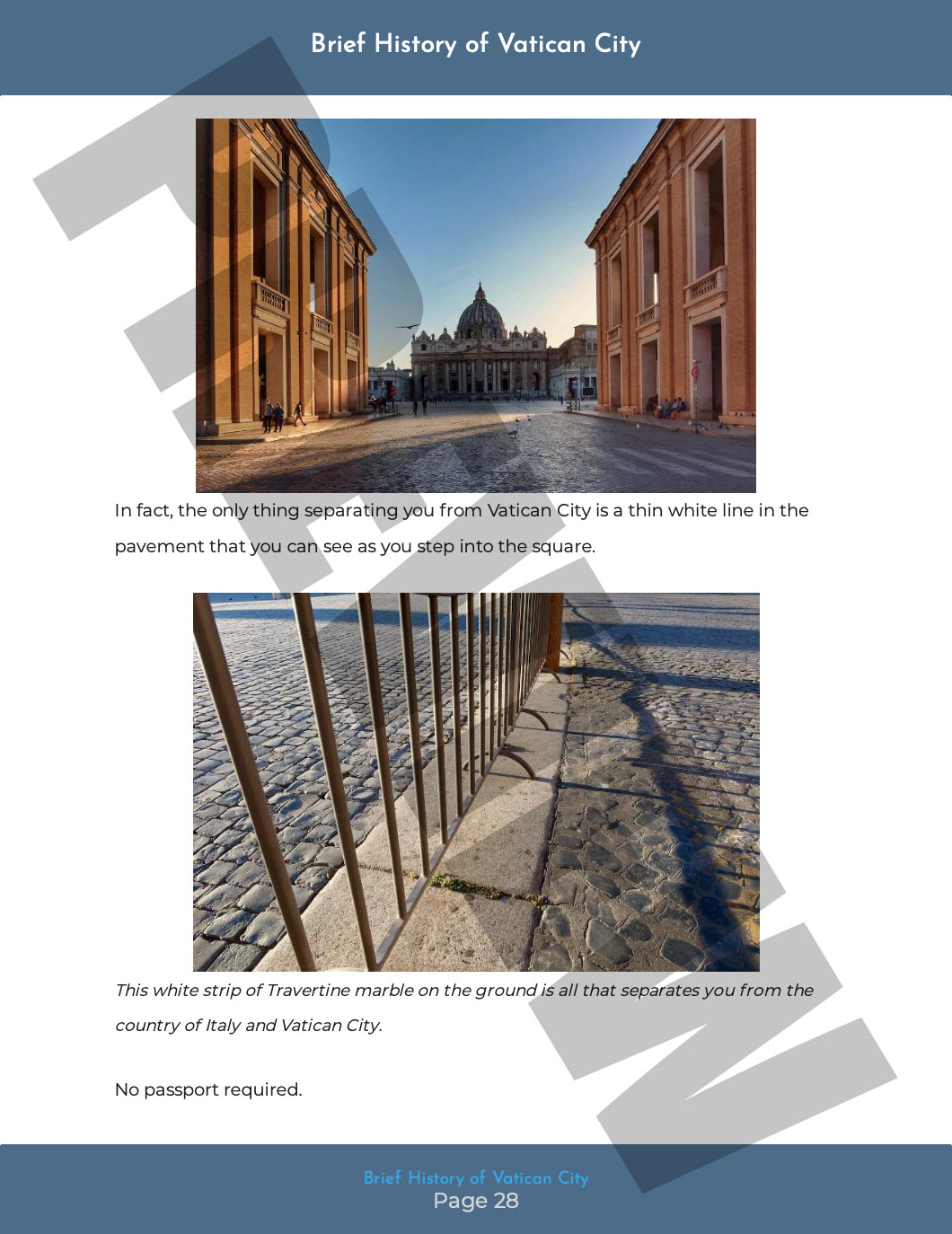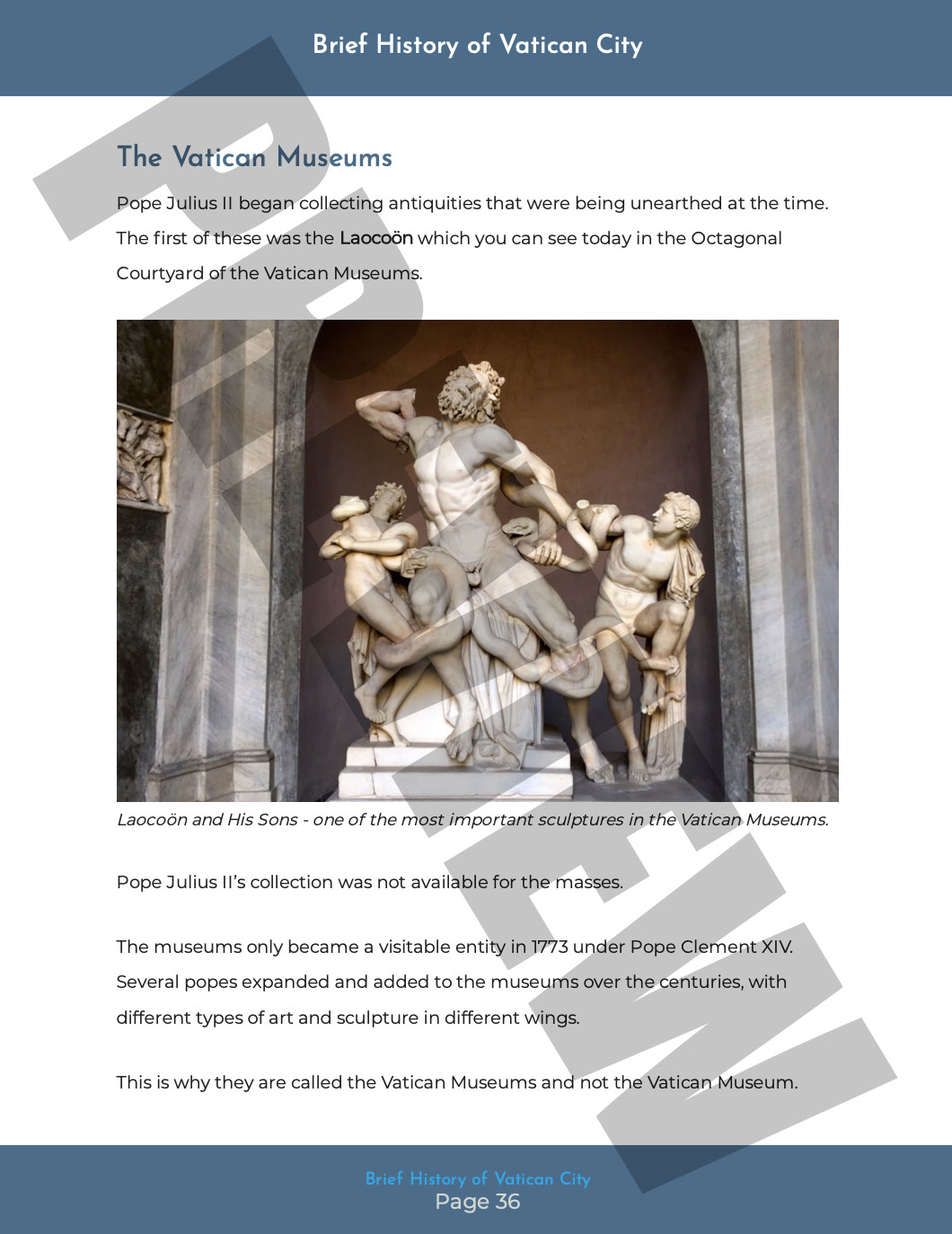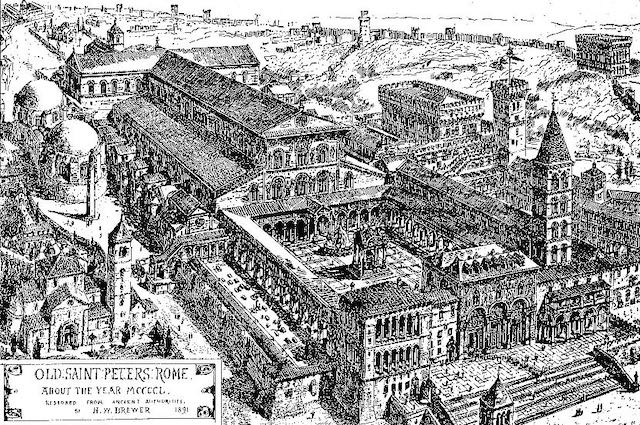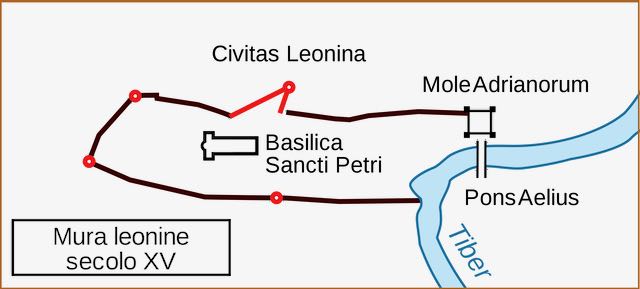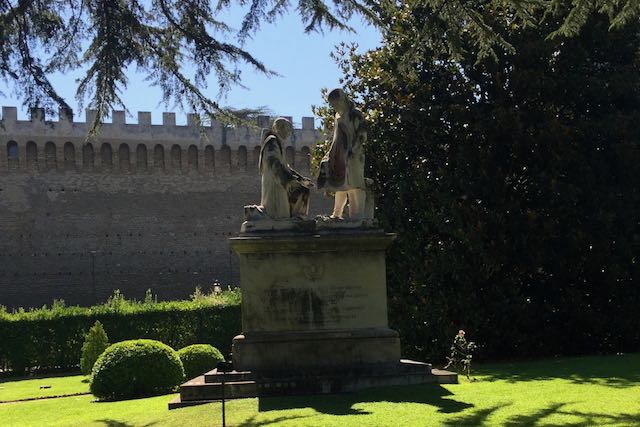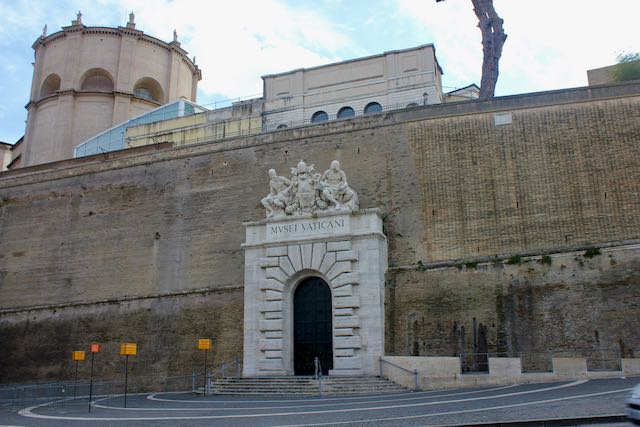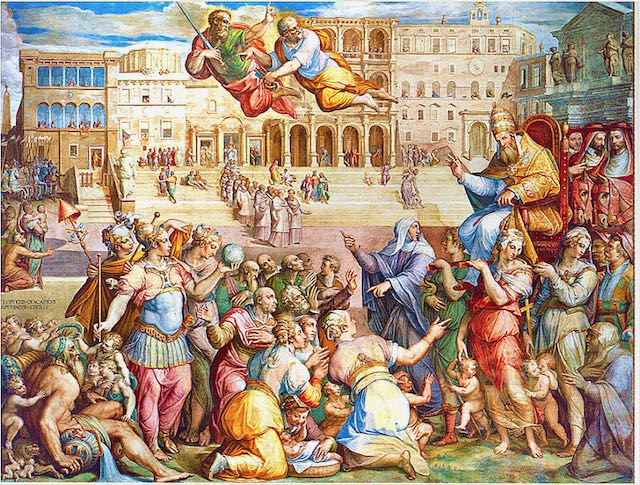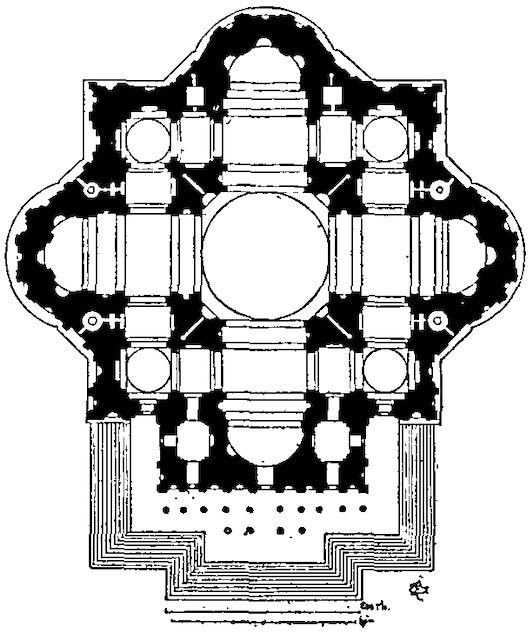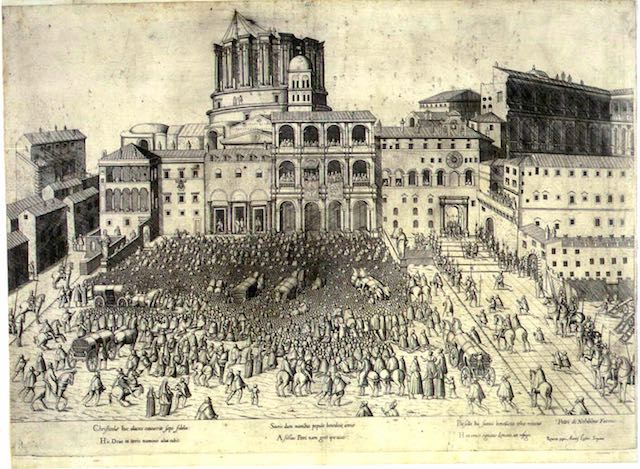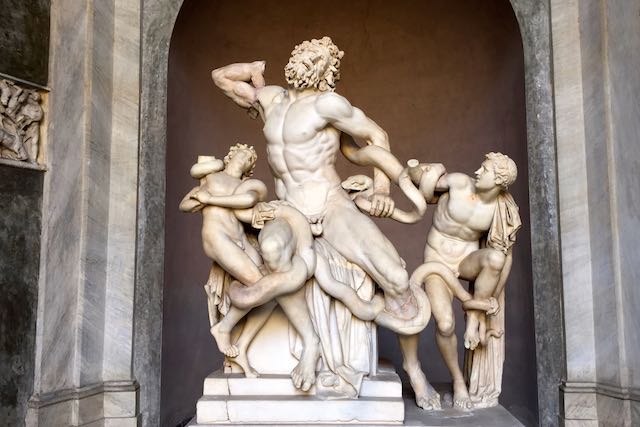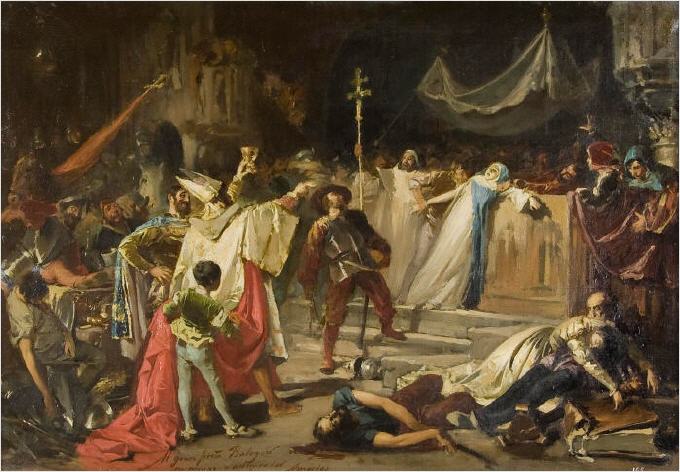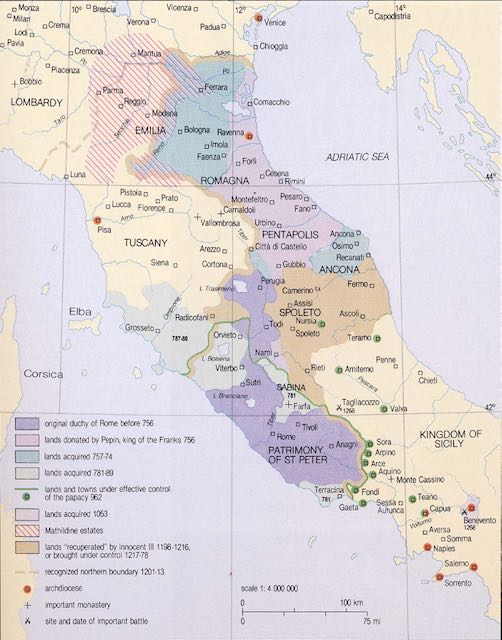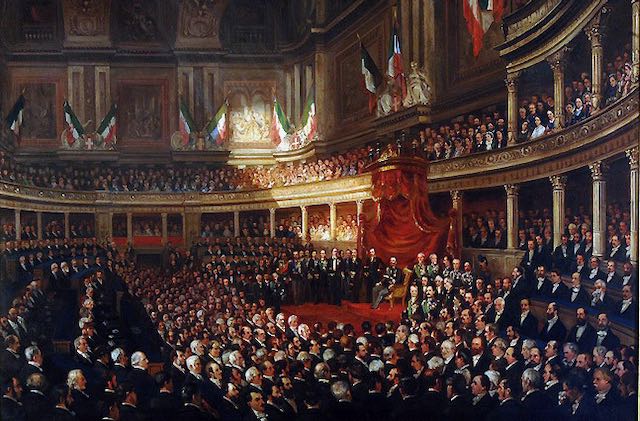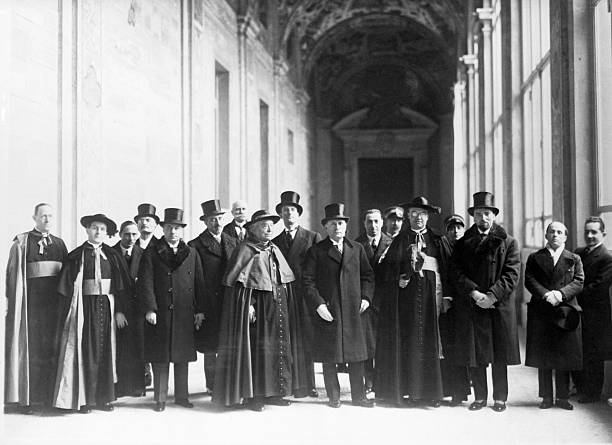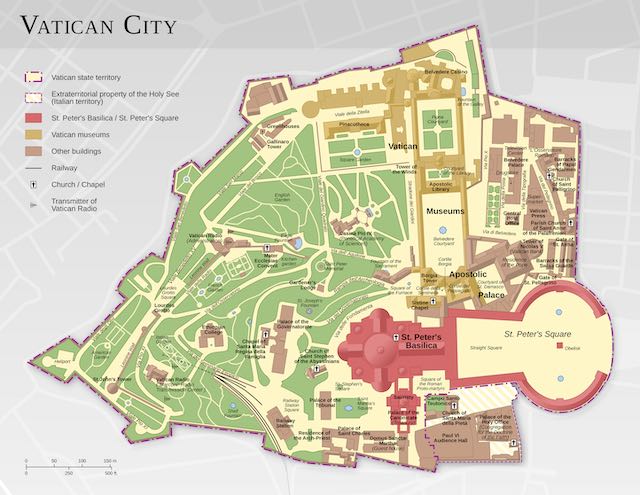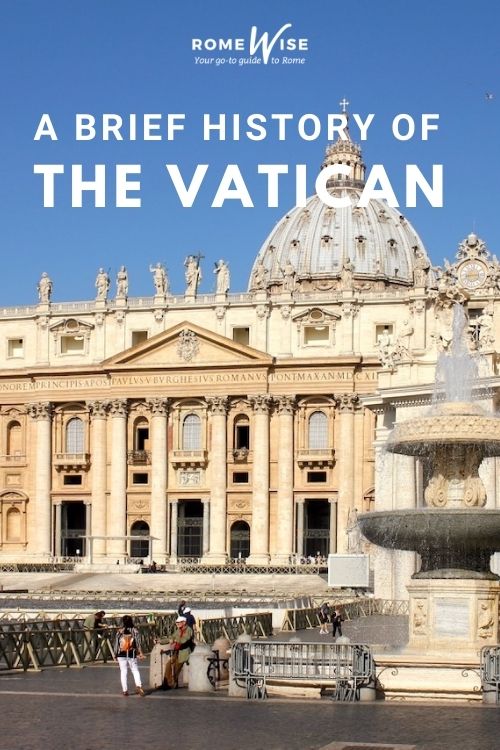- Sign up & get a FREE ebook Subscribe NOW!
- Romewise Home Page
- Visiting the Vatican
- Brief History of Vatican City
Dive Into Our Brief History of Vatican City
Looking for a brief history of Vatican City?
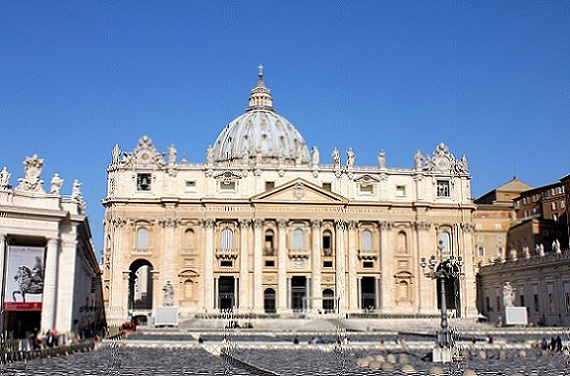 Vatican City is so much more than Saint Peter's Basilica and the Sistine Chapel. Find out why the church is where it is, how the Vatican got its name, and much more
Vatican City is so much more than Saint Peter's Basilica and the Sistine Chapel. Find out why the church is where it is, how the Vatican got its name, and much moreFor a place so ancient, so complex, so influential, this may seem impossible.
Let’s dig in as I cover the most interesting and pertinent parts of how the Vatican came to be one of the most famous places in the world.
A Brief History of Vatican City – Just What You Need to Know
Millions of people visit the Vatican each year but don't stop to ask how this tiny country exists in the heart of Italy's capital city.
The story of how Vatican City came into existence is fascinating, and while I could (and sometimes do) talk for hours about the many twists and turns, most people don't have time for that.
So, here I have brought together the essential parts of the history of the Vatican for you to get to know it better.
On this page you’ll find a brief history of:
Vatican Hill in Ancient Rome
What does Vatican mean?
From the founding of Rome (around 800 BCE) through to the end of the Roman Republic (around 44 BCE), the hill on the west bank of the Tiber River was known as Ager Vaticanus.
During the Roman empire, the Romans referred to this area as Vaticanum, and this was where the rich and powerful built their villas and gardens.
The emperor Caligula (third emperor of Rome, 37 – 41 CE) built a large circus there. This is a type of stadium where chariots and horses would race, like the Circus Maximus.
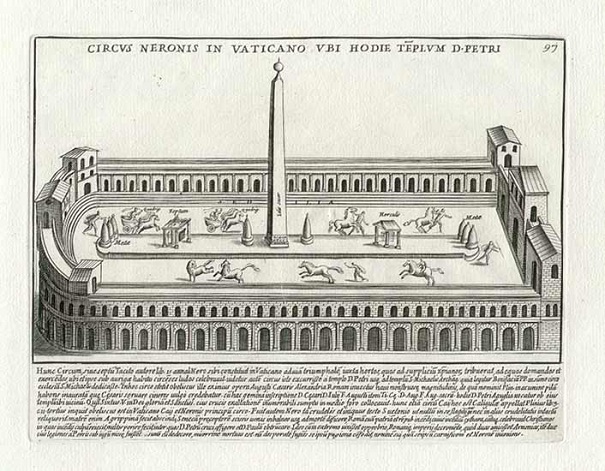 Before the Basilica of Saint Peter, there was Caligula's Circus, which later became known as Nero's Circus.
Before the Basilica of Saint Peter, there was Caligula's Circus, which later became known as Nero's Circus.The Martyrdom of Saint Peter
In 64 CE there was a huge fire in Rome that destroyed more than 2/3 of the city.
According to the historian Tacitus, Nero started the fire himself, so he could rebuild Rome in his image and construct his massive Golden House (Domus Aurea.)
He then decided to persecute Christians as scapegoats.
One of the people he is said to have had murdered is Saint Peter.
Modern historians are less certain about this narrative.
They say Nero was away in Antium when the fire occurred, and that the fire was an accident.
Nero did build the Domus Aurea, which you can visit today, but it’s possible he simply made use of the fire’s devastation to his advantage.
Many modern classicists also dispute the theory that Nero (specifically) persecuted Christians.
Christian tradition holds that Saint Peter was crucified in Nero’s Circus, which was more or less where the Vatican is today.
Brief History of Vatican City eBook
The history of the Vatican stretches back thousands of years, and to know everything about this incredible micro-state would take a lifetime to learn.
With this eBook, discover the brief history of Vatican City - where it got its name, who built the basilica, where the Popes are buried and more!
Topics covered include:
- Details about the Vatican's origin, going back to the time of Ancient Rome
- The role important artists such as Michelangelo played in the creation of the Vatican as we know it today
- How the Vatican came to be an independent city state within the boundaries of Rome
What else is included in this Brief History of Vatican City e-book?
- 50+ pages of information covering all areas of the Vatican's history
- Dozens of stunning and original photos showcasing the Vatican
- Insightful diagrams and drawings to help illustrate the more detailed elements of the Vatican's history
- + much more!
Where is St Peter buried?
In Ancient Rome, it was illegal to bury anyone inside the city.
This is why you find the catacombs outside what was once the city of Rome.
The Vaticanum was outside the city, so people were buried there in what became known as the Vatican Necropolis.
One of those buried here is said to be Saint Peter.
Was Saint Peter ever in Rome?
When I say “tradition holds that Saint Peter was ‘said to be’ martyred and buried here”, it’s because we do not have archeological or biblical proof that he set foot in Rome.
We know that Saint Paul did as he was a Roman citizen.
But with Saint Peter, it’s not certain.
We do have many sites in Rome that are associated with him including the Mamertine Prison, the church of Quo Vadis, the catacombs of Saint Sebastian, and Saint Peter’s Square.
Perhaps one does not need bones or written proof that a place is sacred.
So, it is up to you to decide what to believe.
To read a well-done, in-depth analysis of Peter's life, visit this website.
Disclosure: If you make a purchase through a link on this page, I may receive a small commission - at no extra cost to you. Thank you for supporting my site!
Old St Peter’s Basilica
Emperor Constantine (306 – 337 CE) was the first Roman emperor to sanction Christianity as an official religion of the empire, and (supposedly) the first to convert to Christianity.
He declared a church should be built on top of the resting place of the Apostle Peter. Construction of Constantine’s new basilica began around 319 – 322 CE, and took about 30 years to complete.
Christianity was growing in popularity, and the church became a popular pilgrimage site.
The small shrine that supposedly held the bones of Saint Peter was topped by a canopy with 4 twisted columns from the 2nd century. Twelve more of these columns surrounded the tomb.
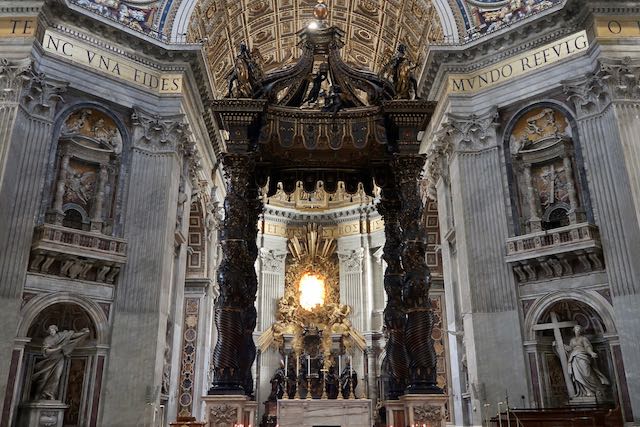 Bernini's baldachin used twisted Solomonic columns. On either side, you can spot four of the original Solomonic columns from Old St. Peter's Basilica.
Bernini's baldachin used twisted Solomonic columns. On either side, you can spot four of the original Solomonic columns from Old St. Peter's Basilica.The twisted columns represented the temple of Solomon, as it too had these types of columns.
Centuries later, Gian Lorenzo Bernini recycled 4 of these original columns to decorate the inside.
Constantine also founded the basilica of St John in Lateran on the other side of Rome.
Jump start your trip to Rome with a free ebook 😀
Sign-up to our free newsletter and receive our Quick Start Guide to Rome ebook which share's everything you need to know to plan the perfect trip to the Eternal City 🙌
The Vatican During the Middle Ages
Once Constantine built his basilica, and pilgrims began coming to Rome, people started donating goods and lands to the Church, making it one of the largest landholders in Europe.
This gave the Church and the papacy more and more legitimacy.
The famed “Donation of Constantine”, which gave the Pope sovereignty over both the Eastern and Western empires where religion was concerned, also helped seal the power of the Church.
In 1440, this document was proved to be a forgery, but by then, the power of the Church in Europe was too strong for this to matter.
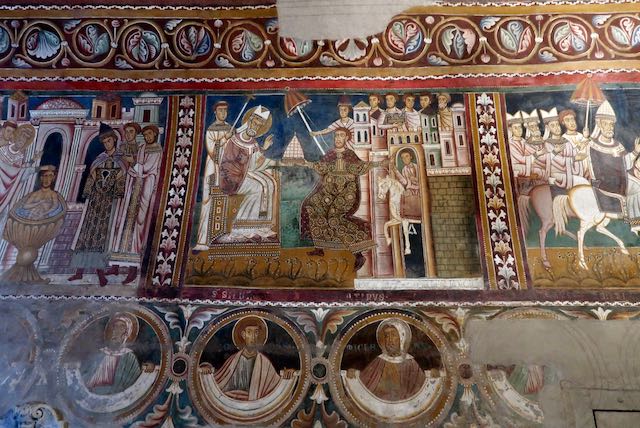 In the medieval chapel of Saint Sylvester in the Basilica of Santi Quattro, you can see one of the most famous depictions of the Donation of Constantine.
In the medieval chapel of Saint Sylvester in the Basilica of Santi Quattro, you can see one of the most famous depictions of the Donation of Constantine.In the 8th century, donations from the Carolingian rulers helped further solidify papal power.
The Papal States was born, and lasted until the unification of Italy in 1870.
On the evening of December 25, 800 CE, Charlemagne was crowned Holy Roman Emperor by Pope Leo III.
This took place on a large porphyry circular stone, which you can see right at the entrance of Saint Peter’s Basilica when you visit today.
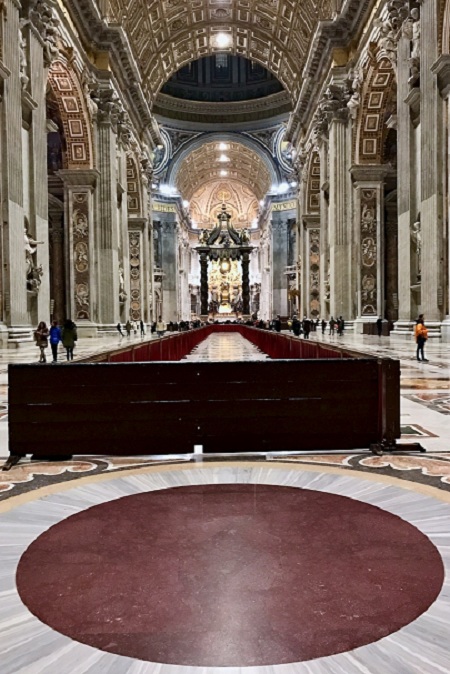 Most people walk on this disc at the front of Saint Peter's Basilica and have no idea what it is. Charlemagne was crowned Holy Roman Emperor on this disc in the year 800 CE.
Most people walk on this disc at the front of Saint Peter's Basilica and have no idea what it is. Charlemagne was crowned Holy Roman Emperor on this disc in the year 800 CE.What was the Holy Roman Empire?
The Holy Roman Empire was a new “Roman Empire” although its heads of state were usually Germanic.
It co-existed with the Papal States from the 8th century through to the 1800s, although at times they each appropriated territory from the other and even went to war.
In 1177, the Treaty of Venice called for the Papal States to become independent of the Holy Roman Empire.
The Leonine Walls
In 846, Saracen pirates sacked St Peter's Basilica.
They were trying for the city, but Rome was impenetrable due to its defensive walls (the Aurelian walls).
The basilica had no protection whatsoever, so it was easier to pillage.
They destroyed Saint Peter’s tomb and other important parts of the building, stealing many valuable items.
Soon thereafter, Pope Leo IV had defensive walls built around the basilica.
They created a 2-mile boundary for what would become known as the Leonine City.
The 39-foot high walls were called the Leonine Walls.
You can still see remnants of them in Rome.
Part of this wall is inside the Vatican Gardens, and part of the wall runs along the Borgo between the basilica and Castel Sant’Angelo.
The walls were continually expanded and modified through to the reign of Pope Urban VIII in the 1640s.
Today you can see many remnants of these walls.
You might see the papal coat of arms indicating which pope was in charge of a particular modification.
Today there are 6 entrances to Vatican City, but the main entrance to Vatican City is Saint Peter’s Square.
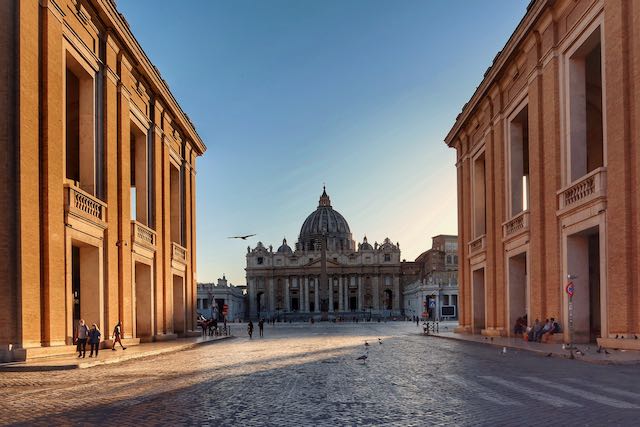 One of the easiest ways to enter Vatican City is right from the front, straight onto Saint Peter's Square.
One of the easiest ways to enter Vatican City is right from the front, straight onto Saint Peter's Square.In fact, the only thing separating you from Vatican City is a thin white line in the pavement that you can see as you step into the square.
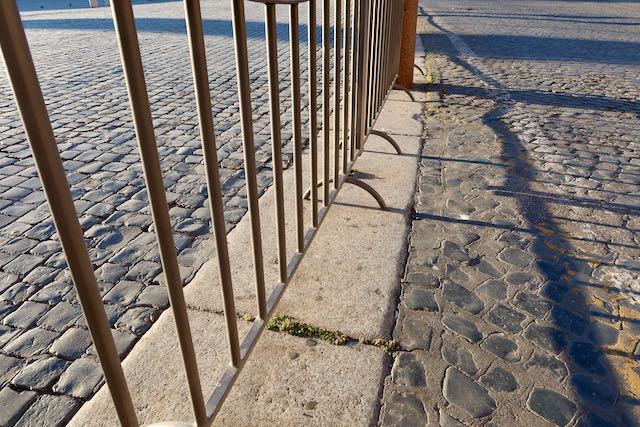 This white strip of Travertine marble on the ground is all that separates you from the country of Italy and Vatican City.
This white strip of Travertine marble on the ground is all that separates you from the country of Italy and Vatican City.🇻🇦 Visit the Vatican 🇻🇦
Experience the best of the Vatican.
Enjoy easy access to the Vatican Museums, Sistine Chapel,
and St. Peter’s Basilica for an unforgettable experience
with these recommended tours.
The Vatican During the Renaissance
In 1309 the Papal court moved to Avignon, France due to a disagreement that arose after French king Philip IV went behind everyone’s backs and elected a French pope, Clement V, in 1305.
Pope Gregory XI moved the court back to Rome in 1376, but the long years of abandonment had taken a toll on Rome.
Large parts of the city were in ruin and St. Peter’s Basilica had fallen into disrepair.
In the mid 1400's, Pope Nicholas V decided to live permanently inside Vatican City. He had the old Apostolic Palace destroyed and a new one built for him to live in.
This was the start of a series of building projects and improvements that created what we see today in Vatican City.
Pope Julius II and the New Basilica
At the end of the 1400's, Pope Julius II had begun to think of plans to preserve the 1200-year old basilica. But it was becoming evident that this was not possible.
It was leaning to one side and was not big enough to fit an enormous, heavy tomb Julius had commissioned Michelangelo to design for himself. Julius began to consult with his favorite architect, Donato Bramante, about ideas for a new basilica.
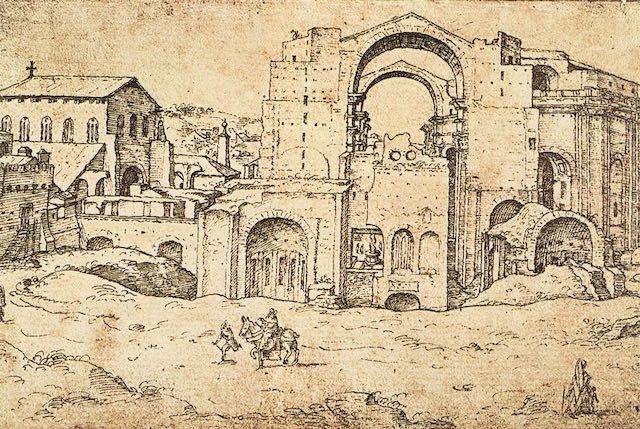 Maerten van Heemskerck, 1532-1536. Northern Dome Pillar of New St. Peter’s Basilica and the remaining Northern Transept of the old Basilica.
Maerten van Heemskerck, 1532-1536. Northern Dome Pillar of New St. Peter’s Basilica and the remaining Northern Transept of the old Basilica.This was shocking at the time, since the basilica was so connected to Saint Peter.
But as it was next to impossible to repair the basilica, the decision was made to preserve St Peter's tomb while creating a new and more beautiful structure around it.
Pope Julius died in 1513, as did Bramante.
Subsequent popes consulted many architects to come up with a design for the new basilica. But eventually the entire task was entrusted to a 70-something Michelangelo in the mid 1500's.
While he was no fan of Bramante or Raphael, Michelangelo did adhere to their original idea of a Greek-cross design for the new building (a Greek cross has 4 equal arms, while a Latin cross has two long arms and two shorter arms.)
Later architects Gian Lorenzo Bernini and Carlo Maderno added a long nave, returning the church’s shape to a Latin cross.
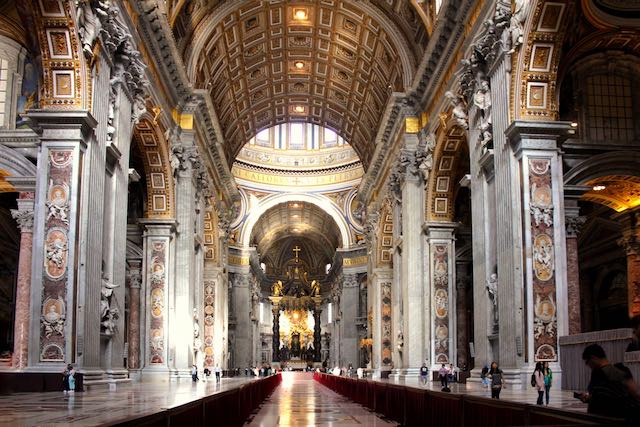 In the mid-1600s, about 100 years after Michelangelo's death, the long central nave of Saint Peter's Basilica was added to his original design.
In the mid-1600s, about 100 years after Michelangelo's death, the long central nave of Saint Peter's Basilica was added to his original design.Pope Julius was also responsible for establishing two other very important aspects of today’s Vatican – the Vatican Museums and the Swiss Guard.
Ready to plan your trip?
Book your train
Planning to travel between cities in Italy and other parts of Europe?
Use Trainline to see all the different options available across the different rail companies.
Find your hotel
Find your perfect place to stay in Rome.
Use Booking.com to choose between hotels, guesthouses, and self-catering apartments in neighborhoods throughout the Eternal City.
Buy your TurboPass
Purchase the convenient Turbopass and visit all of Rome's top attractions including the Colosseum, Pantheon, and Vatican.
With one handy pass, it's all included.
The Vatican Museums
Pope Julius II began collecting antiquities that were being unearthed at the time.
The first of these was the Laocoön which you can see today in the Octagonal Courtyard of the Vatican Museums.
Several popes expanded and added to the museums over the centuries, with different types of art and sculpture in different wings. This is why they are called the Vatican Museums and not the Vatican museum.
The 1527 Sack of Rome
On May 6 1527, troops loyal to Charles V, Holy Roman Emperor, mutinied over unpaid wages.
These foreign soldiers didn’t just sack Rome but nearly razed it to the ground. The attack was savage and vicious, far more than a simple taking-over of the city.
Of the 189 Swiss Guard in place, 147 of them died in front of St Peter’s Basilica protecting Pope Clement VII.
The pope managed to escape with the other 42 Swiss Guards by using the passageway on top of the Leonine Walls that led to the fortress of Castel Sant’Angelo.
To save his life, Pope Clement VII eventually paid a large ransom, and gave up some Papal territories to the Holy Roman Empire.
The Dramatic Change in Europe's History
The Sack of Rome in 1527 was a huge turning point.
King Charles V and Pope Clement VII's relationship was changed permanently. Clement VII was humiliated and weakened by his experience and in order to avoid any further conflict, the pope did everything Charles V wanted.
One of the major decisions the pope took was to refuse to grant England’s King Henry VIII an annulment of his marriage to Charles V’s aunt, Catherine of Aragon. This caused Henry to break with Rome, leading to the English Reformation.
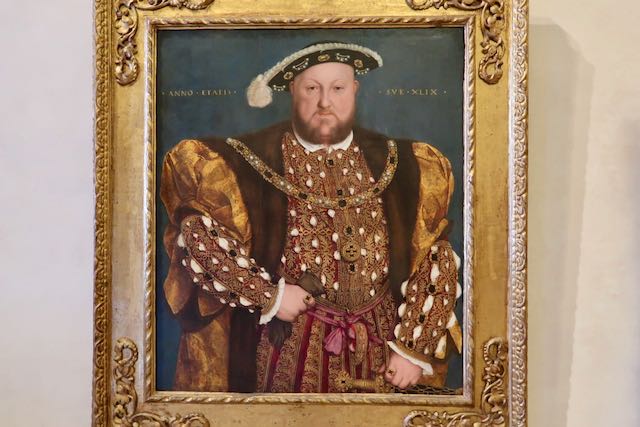 Portrait of Henry VIII - Hans Holbein the Younger, 1540. Galleria nazionale d'arte antica (Palazzo Barberini), Rome.
Portrait of Henry VIII - Hans Holbein the Younger, 1540. Galleria nazionale d'arte antica (Palazzo Barberini), Rome.The End of the Renaissance
This was pretty much the end of the Roman Renaissance, even though Michelangelo would go on to paint his Last Judgement in the Sistine Chapel.
The calamity of the Sack of Rome darkened Michelangelo's mood further, something you can see reflected in the painting style in the Last Judgement compared to the work he did when he painted the Sistine Chapel ceiling as a young man.
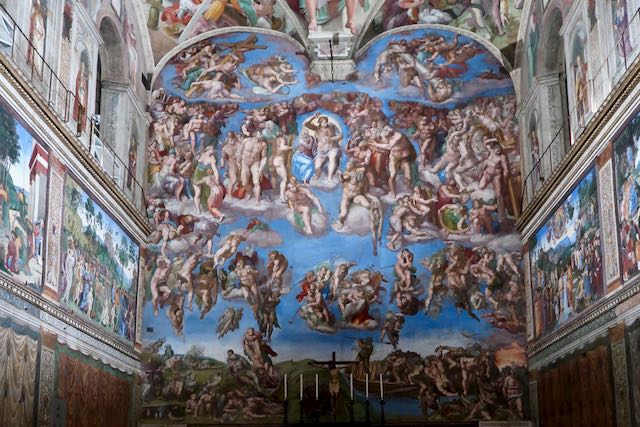 The Last Judgement by Michelangelo reflects a darker mood after the 1527 Sack of Rome.
The Last Judgement by Michelangelo reflects a darker mood after the 1527 Sack of Rome.While the Renaissance was a time of enlightenment, the period after the Sack of Rome was much more somber.
The Church needed to fiercely promote the Counter-Reformation in response to the rise of Protestant ideas in England and Germany. This led to the annexing of Rome’s Jews to the Ghetto, the Spanish Inquisition, and other draconian measures across the territory the Church still controlled.
The population in Rome dropped to fewer than 10,000 people. Thousands had perished in the attack but many more died later from disease. Even more people left the city due to lack of food and funds.
Rome and the Vatican did eventually recover, but there was a long period of hardship for those who remained.
How the Vatican Gained its Independence as a Sovereign City-State
The Papal States
The Papal States were territories under the direct jurisdiction of the pope until 1870, when a unified Italy claimed all land outside Vatican Walls.
At their peak, the Papal States had over 3 million citizens and included the regions we know today as Lazio, parts of Umbria, le Marche, and Emilia Romagna.
Unification of Italy
In 1850, King Victor Emmanuel II (who commissioned the huge Vittoriano monument) began to consolidate all of Italy under one government.
He would become the first king of a unified Italy.
The largest state, and the last holdout to joining a unified Italy, was the Papal States.
The king began annexing pieces of the Papal States, bit by bit, until all that was left was Rome.
The domain of the Holy See had shrunk to the area inside the Vatican Walls.
On September 20, 1870, the king’s army forcibly occupied Rome.
The king offered Pope Pius IX various concessions if the pope would acknowledge the new Italian state and agree to the annexation of the Papal States.
The pope refused, as the compromise did not allow for absolute power of the Holy See over the Church and the physical territory it still owned.
Pope Pius IX and his successors secluded themselves in the Vatican for 59 years, proclaiming themselves “prisoners of the Vatican.”
They refused to legitimize the Italian government or its rights to the Papal States. This became known as “The Roman Question.”
The Lateran Pact
In 1927, prime minister Benito Mussolini entered into new negotiations with Pope Pius XI.
By this time, it had become apparent that most Italians wanted peace between the two. Also, most Italians were Roman Catholic, so it made sense to find a way to rule in harmony.
On February 11 1929, Italy and the Vatican signed the Lateran pact. The Holy See acknowledged the legitimacy of the Italian government and its right to the Papal States.
The Creation of Vatican City
Vatican City was created as part of the Lateran pact.
Italy agreed to recognize Vatican City as a sovereign nation, independent of Italy, with the pope as its head of state.
Italy financially compensated the new city-state with money and property in other parts of Rome, and also provided them with a train station, telephone and telegraph office, radio station, and post office.
Italy adopted many rules of the Church as Italian law, including marriage laws and religious teaching in public schools.
The Italian government had hoped that the accord would diminish the role of the pope as temporal ruler. Clearly this did not turn out to be the case, as the pope today is considered a world leader with considerable influence.
Romewise's Top Travel Resources
Ready to book your trip to Rome? Take a look at these helpful links to companies we use and trust:
- Keep your travel spending simple with the Wise card, which removes all the worry about exchange rates and high transaction fees all over the world
- Search for and book your perfect accommodation
- Our complete guide to what to pack for Rome
- The number one travel accessory, a multi-point travel adapter and voltage converter
- Browse a huge range of tours in Rome and beyond
- Experience unique tours and special access to Rome's most popular sights
- Protect yourself with comprehensive travel insurance
Within this post there are some affiliate links for products and services. For more details about our affiliate policy click here.
Get your 100% free Rome trip planner now!
Simply sign-up today for our free newsletter and get the Romewise Quick Start guide to Rome:
We are committed to respecting your data. Click for our Privacy Policy.
Comments? Questions? Suggestions?
Please come over to the private Romewise Facebook group and join in the conversation.
You will often find me there, happy to answer your questions / comments!
You will also meet other Rome lovers and experts, too.
What are you waiting for?
- Romewise Home Page
- Visiting the Vatican
- Brief History of Vatican City

